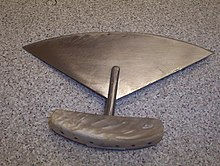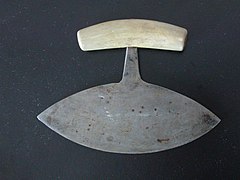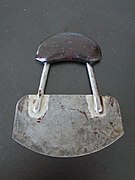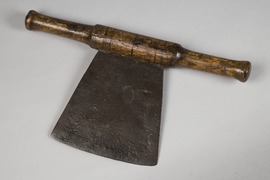FAIR and interactive data graphics from a scientific knowledge graph
Contents

An ulu (Inuktitut: ᐅᓗ; plural: uluit; sometimes referred to as 'woman's knife') is an all-purpose knife traditionally used by Inuit, Iñupiat, Yupik, and Aleut women. It is used in applications as diverse as skinning and cleaning animals, cutting a child's hair, cutting food, and sometimes even trimming blocks of snow and ice used to build an igloo.[1] They are widely sold as souvenirs in Alaska.
Name
In the Nunatsiavummiutut variety of Inuttitut, which is spoken in Nunatsiavut (Northern Labrador), the word is spelled uluk, and in Tunumiisut (East Greenlandic) it is sakiaq or saakiq.[2]
The following chart lists both Eskaleut terms as well as two terms for the same tool in Athabaskan languages, which are an unrelated language family spoken by non-Inuit-Iñupiat-Aleut Alaska Natives.
| language | singular | dual | plural |
|---|---|---|---|
| Yukon-Kuskokwim Yup'ik[3] | uluaq | uluak | uluat |
| Chevak Cup'ik (a Yupik language)[3] | kegginalek | kegginalgek | kegginalget |
| Nunivak Cup'ig (a Yupik language)[3] | ulluar | ||
| Iñupiaq language[4] | ulu ~ uluuraq | ||
| Inuinnaqtun / Inuvialuktun (Central / Western Canadian Inuit language)[5] | ulu | ||
| Inuktitut (Eastern Canadian Inuit language)[6] | ulu (ᐅᓗ) | uluuk (ᐅᓘᒃ) | uluit (ᐅᓗᐃᑦ) |
| Inuttitut (an Eastern Canadian Inuit language)[7] | uluk | ulok | uluit |
| Greenlandic (Western Greenlandic Inuit language)[8] | ulu | ulut | |
| Tunumiisut (East Greenlandic Inuit Language)[9] | sakiaq ~ saakiq | ||
| Koyukon (an Athabaskan language)[10] | tlaabaas | ||
| Holikachuk (an Athabaskan language) | tthamas |
Materials
Traditionally the ulu was made with a caribou antler,[11] muskox horn,[12] or walrus ivory[13] handle and slate cutting surface, due to the lack of metal smelting technology in the Arctic.[14] The handle could also be carved from bone, and wood was sometimes used when it was available.[15] In certain areas, such as Ulukhaktok ("where there is material for ulus"),[16] Northwest Territories, copper was used for the cutting surface.[17]
The modern ulu is still often made with a caribou antler handle but the blade is usually made of steel. The steel is often obtained by purchasing a hand saw or wood saw and cutting the blade to the correct shape.[18] A hardwood called sisattaq is also used for handles. Uluit are often home made, but there is also an industry of commercially produced uluit, sometimes made with a plastic handle and complete with a cutting board.[19]
The Copper Inuit of Victoria Island used copper they mined to make ulu blades.[20] When slate and copper were scarce, some Inuit turned to whale baleen or ivory for the blades.[21]
Usage and styles

The size of the ulu typically reflects its usage. An ulu with a 5 cm (2.0 in) blade would be used as part of a sewing kit to cut sinew or for cutting out patterns from animal skins to make Inuit clothing and kamiit (shoes). An ulu with a 15 cm (5.9 in) blade would be used for general purposes. Occasionally, uluit can be found with blades as large as 30 cm (12 in).[22][23]
The ulu comes in four distinct styles, the Iñupiat (or Alaskan), Canadian, Kalaallit (West Greenlandic) and Tunumiit (East Greenlandic). With the Iñupiat style ulu, the blade has a centre piece cut out and both ends of the blade fit into the handle.[24] In Canada, the blade more often is attached to the handle by a single stem in the centre. In the western areas of the Canadian Arctic, the blade of the ulu tends to be of a triangular shape, while in the eastern Arctic, the ends of the blade tend to be more pointed.[25][26]
The shape of the ulu ensures that the force is centred more over the middle of the blade than with an ordinary knife. This makes the ulu easier to use when cutting hard objects such as bone. Because the rocking motion used when cutting on a plate or board with an ulu pins down the food being cut, it is also easier to use an ulu one-handed (a typical steak knife, in contrast, requires a fork).[27]
Uluit are sometimes used for purposes other than their original intent. Because of their cultural symbolism throughout the Arctic, they are sometimes presented to people who have accomplished significant achievements in fields such as sports or education. Specifically, the Arctic Winter Games presents ulu-shaped medals to successful athletes, acting in place of a regular medal.[28]
Uluit are also used as an educational resource, as they can useful in teaching geometry, the history of circumpolar peoples, the role of Inuit women, an understanding Inuit culture, and traditional tool use.[29]
History
Uluit have been found that date back to as early as 2500 BCE.[21]
Blades of the first uluit were made out of stone,[30] but after making contact with whalers in the 19th century, the material used for blades changed quickly to steel.[31] By the 1880s in Alaska, the Iñupiat began to frequently transform steel saw blades into ulu blades.[18]
In the early 20th century ulu collections were displayed to the American public, lending support to an interest in Arctic exploration and in studying the culture of indigenous people of the north. Later, the uluit were also produced as souvenirs for the exchange of goods with sailors, and could often have no utilitarian value.[32]
Since 1970, in the Arctic Winter Games small ulu-shaped medals have been given to the winners.[33] There are gold and silver ulu medals, as well as bronze ones,[34] which replaced the formerly used copper ulu medals.[35]
In 2019 Robin Anna Smith won third place in "The Peggy Willis Lyles Haiku Awards for 2019" of "The Heron's Nest" magazine,[36] with an English-language haiku about an ulu:
carving
the snow
ulu moon.
Ulu knives are widely sold to tourists as souvenirs throughout Alaska.[37]
Legality
Some countries, including Canada, prohibit the possession or carrying of knives where the blade is perpendicular to the handle (intended to limit the use of so-called "push daggers"). However, regulations passed under the Criminal Code[38] specifically exempt the "aboriginal 'ulu' knife" from this prohibition.[39]
In the United States uluit are not allowed on commercial airline flights as carry-on luggage, though they can be in checked baggage.[40]
Gallery
-
West Greenlandic (Kalaallit) ulu
-
East Greenlandic (Tunumiit) ulu
-
An ulu from Alaska
-
19th century Italian knife for meat (mannaia tritacarne), resembling an ulu and having a similar function
See also
References
- ^ "The Ulu: Chemistry and Inuit women's culture". Chem 13 News Magazine. 8 February 2019. Retrieved 15 October 2023.
- ^ "Hafted Scraper". Museum of Stone Tools. Retrieved 15 October 2023.
- ^ a b c Jacobson, Steven A. (2012). Yup'ik Eskimo Dictionary, Volume 1 (2nd ed.). Alaska Native Language Center, University of Alaska Fairbanks. p. 669. ISBN 978-1-55500-115-5.
- ^ MacLean, Edna Ahgeak (1981). Abridged lnupiaq and English Dictionary (in English and Inupiaq). North Slope Borough, Alaska: Alaska Native Language Center, University of Alaska Fairbanks. p. 70. ISBN 978-0-93376-919-9.
- ^ Ohokak, Gwen; Kadlun, Margo; Harnum, Betty (2012). Angulalik, Gwen (ed.). Inuinnaqtun English Dictionary (in English and Western Canadian Inuktitut). Inhabit Media Inc. p. 97. ISBN 978-1-92709-524-9. Retrieved 10 January 2024.
- ^ "Inuktut Glossary | Inuktut Tusaalanga". www.tusaalanga.ca. Retrieved 15 October 2023.
- ^ "Inuttut-English Dictionary". www.labradorvirtualmuseum.ca. Retrieved 15 October 2023.
- ^ "Greenlandic-English Dictionary (2018) – The University of Chicago & Oqaasileriffik". ordbog.gl. Retrieved 15 October 2023.
- ^ Mennecier, Philippe (1995). Le Tunumiisut, dialecte Inuit du Groenland oriental. Description et analyse (in French and Kalaallisut) (1st ed.). Klincksieck. p. 244. ISBN 978-2-252-03042-4.
- ^ Jones, Eliza (1978). JUNIOR DICTIONARY for CENTRAL KOYUKON ATHABASKAN. National Bilingual Materials Development Center, Rural Education, University of Alaska, Alaska. p. 181.
- ^ "35. Artifacts | The Nick Newbery Photo Collection". www.newberyphotoarchives.ca. Retrieved 15 October 2023.
- ^ "ulu | British Museum". The British Museum. Retrieved 15 October 2023.
- ^ "1190 – Ulu handle for a slate/flint blade". Sainsbury Centre. Retrieved 15 October 2023.
- ^ "Civilization.ca – Nadlok – Glossary – Ulu". civilization.ca. Retrieved 15 October 2015.
- ^ "Hooper Bay's dunes, home to the community's cultural history, are slipping into the sea". KYUK. 13 October 2023. Retrieved 15 October 2023.
- ^ "Northwest Territories Official Community Names and Pronunciation Guide". Prince of Wales Northern Heritage Centre. Yellowknife: Education, Culture and Employment, Government of the Northwest Territories. Archived from the original on 13 January 2016. Retrieved 10 January 2024.
- ^ "Ulu with a musk ox horn handle". Google Arts & Culture. Retrieved 15 October 2023.
- ^ a b Button Kambic, Emily (2015). "The Changing Lives of Women's Knives: "Ulus", Travel, and Transformation". Historical Archaeology. 49 (3): 40. JSTOR 24757024 – via JSTOR.
- ^ Ulu Factory. "Specializing in the Manufacture of Ulu Knives, Handle Assembling & Packaging for Distribution".
- ^ Morrison, David A. (January 1987). "Thule and Historic Copper Use in the Copper Inuit Area". American Antiquity. 52 (1): 5. doi:10.2307/281056. JSTOR 281056. S2CID 163911997.
- ^ a b Library and Archives Canada Blog (25 February 2019). "The Inuit Ulu – Diverse, Strong, Spiritual". Library and Archives Canada Blog. Retrieved 15 October 2023.
- ^ Abdullah (3 February 2023). "7 Detailed Ulu Knife Uses|Types, Steps, History & Guidance (2023)". KnifeFlow. Retrieved 16 October 2023.
- ^ "Ulu Knife crafted by Northern Alaska Native Artists". www.arcticspiritgallery.com. Archived from the original on 1 December 2018. Retrieved 16 October 2023.
- ^ "External image on the Inuipat style ulu". Archived from the original on 15 June 2006. Retrieved 2 January 2006.
- ^ "Civilization.ca – Nadlok – Artifacts – Ulus". civilization.ca. Retrieved 15 October 2015.
- ^ "Ulu – Contemporary Canadian Native, Inuit & Aboriginal Art – Bearclaw Gallery". Archived from the original on 5 June 2013. Retrieved 16 October 2023.
- ^ Sun, Xuemei (15 February 2021). "What is the Ulu used for?". Proudly Indigenous Crafts & Designs. Retrieved 16 October 2023.
- ^ "Arctic Winter Games: Tuesday, January 31-Team Alaska collects 8 ulu medals". KNBA. 31 January 2023. Retrieved 16 October 2023.
- ^ Lynch, Matthew (4 September 2023). "Unleashing the Educational Potential of the Ulu". The Edvocate. Retrieved 16 October 2023.
- ^ "Alutiiq Museum : Word of the Week : Ulu [AM888.444]". alutiiqmuseum.org. Retrieved 15 October 2023.
- ^ Button Kambic, Emily (2015). "The Changing Lives of Women's Knives: "Ulus", Travel, and Transformation". Historical Archaeology. 49 (3): 39–40. JSTOR 24757024.
- ^ Button Kambic, Emily (2015). "The Changing Lives of Women's Knives: "Ulus", Travel, and Transformation". Historical Archaeology. 49 (3): 42–47. JSTOR 24757024.
- ^ Adderley, Jack (9 March 1970). "We're going to have a Winner". The Ulu News. p. 2.
- ^ "Arctic Winter Games 2006: Medal standings". awg2006.kimik-it.gl. 13 March 2006. Archived from the original on 28 January 2017. Retrieved 16 October 2023.
- ^ Hopwoad, John; McAleer, Wes (1970). Arctic Winter Games (PDF). Yellowknife, Northwest Territories: Arctic Winter Games Corporation. p. 21.
- ^ "The Heron's Nest – Awards & Contests, 2019". theheronsnest.com. Retrieved 16 October 2023.
- ^ Spray, Zona (2001). "Memories of a Vanishing Eskimo Cuisine". Food and the Memory: Proceedings of the Oxford Symposium on Food and Cookery, 2000. Prospect Books. p. 264. ISBN 978-1-903018-16-3. 9781903018163.
- ^ Branch, Legislative Services (22 June 2023). "Consolidated federal laws of Canada, Criminal Code". laws-lois.justice.gc.ca. Retrieved 15 October 2023.
- ^ Branch, Legislative Services (1 May 2020). "Consolidated federal laws of Canada, Regulations Prescribing Certain Firearms and Other Weapons, Components and Parts of Weapons, Accessories, Cartridge Magazines, Ammunition and Projectiles as Prohibited or Restricted". laws-lois.justice.gc.ca. Retrieved 15 October 2023.
- ^ "Souvenir ulus among items most caught at TSA checkpoint in Fairbanks". Fairbanks Daily News-Miner. 18 May 2014. Retrieved 15 October 2015.
External links
Images and collections
- Collection of uluit in the National Museum of the American Indian
- Images and descriptions of uluit and other Inuit tools and clothing at McCord Museum
Demonstrations and tutorials
- An article about Ulu that has a section on how to use it
- YouTube video demonstrating the usage of an ulu
- YouTube video titled "The Fastest Woman with an Ulu" featuring Marjorie Tahbone, who won first place in fish-cutting competition at the World Eskimo Indian Olympics in 2016, showing her fast-cutting abilities
- YouTube video showing the full proces of making an ulu knife
- YouTube video of an Inuit person skinning seal with an ulu





















